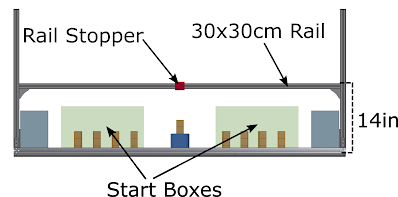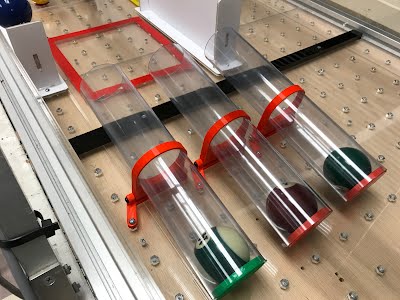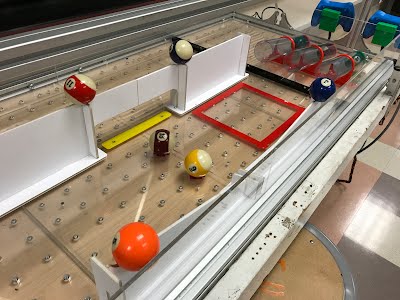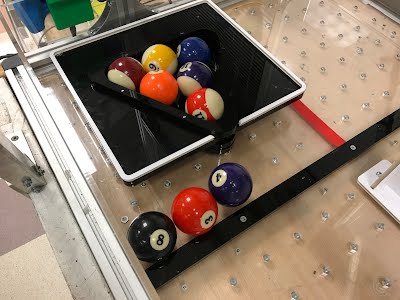Professors Garay, Gravish, and Delson decided to visit the billiard tables on campus one Friday evening to celebrate what a great group of MAE 3 students they had this quarter. Profs G, G, and D love to play billiards and sometimes even will have friendly wagers to motivate competition. However, on this particular afternoon playing a game of 6 ball (a variant of 9 ball billiards that your profs enjoy so much) an argument broke out. Every time professor Gravish racked the balls professor Garay could not get a ball in on the break. After some heated words, professor Delson calmed the professor Gs down.
"Guys, guys, there is no need to fight about a pool game. If I am going to play with you two at all in the future we need to have an impartial racking method" Said prof. Delson
"I don't know Prof D, I think it will be pretty hard to make a mobile robot that can rack a game of 6 ball in 60 seconds. Pool balls are slick and they are pretty heavy at 160 grams each." Said prof. Gravish
"I have just the group of engineers who can solve this challenge!" Said prof Delson.
Enter out intrepid engineers in MAE 3 to solve this issue. Your MAE 3 professors are challenging you the students to devise a racking robot, capable of collecting billiard balls distributed across the competition arena and racking them for a game of 6 ball billiards. This robot competition is not for the faint of heart however. There are significant challenges that need to be overcome:
- Interacting with dynamic features of the arena to collect billiard balls.
- Manipulating the smooth billiard balls and transporting them across the arena.
- Lifting and placing groups of heavy billiard balls.
- All of this is to be done using low power motors, custom fabricated transmissions and drive trains, and limited to four control inputs.
%%%%%%%%%% END OLD STUFF
Playing Field:
60 Second Competition:
Two robots will compete head to head for 60 seconds. Robots will try to collect and stack as many wooden blocks as possible. All scoring will be done at the completion of the contest after all parts have finished moving.
Wooden Block Collection Sites:
There are several areas where wooden blocks can be collected. Each side has 24 blocks and the center divider has 18 blocks, making a total of 66 blocks on the contest table.
Block Size: 3.8x3.8x3.8cm (1.5x1.5x1.5in) Block Mass: XXXg (xxx oz)

The Scoring Area: rebuilding the wall
Wooden blocks must be collected and placed onto the scoring platform to get points. Blocks are scored based on their height from the ground. Blocks higher off the ground are worth more points.
Scoring Platforms
The scoring zones are shown
In order for the block to be scored, it must satisfy all three of these criterion once the clock stops: - The block cannot be touching the robot
- The block must either be touching the scoring platform, or touching another block that is touching the platform, and etc...
- The entire block must be higher than the scoring zone to obtain maximum points.
The Starting Boxes and The Rail:
The playing fields have a rail that students may attach robots do. The top of the rail is 14in from the ground and contains a stopper in the center. Robots must start within their designated starting area on opposing sides of the table and must fit within a 10x10x18in box.
Teams may choose to start either on the ground or on the rail. A rail starting robot must be no higher than 16in and no lower than 6in from the ground. This leaves 2in above the rail to build a drivetrain mechanism. The starting locations are shown below.
Tie Breakers:
In the case of a tie, the team who placed the first block in their scoring area wins the tiebreaker.
Actual Photos:
General MAE3 Competition rules:
A complete list of rules is provided at the end of this document, and any clarifications to the rules will be posted at the end of this webpage throughout the quarter. However, some key rules are:
- Robot setup time on the contest table cannot exceed 2 minutes.
- Manufacturing variations will exist between playing fields. It is the team's responsibility to design a robot that will work on all contest tables.
- Each robot must only be built out of kit parts provided.
- Robots must be built in the Design Studio only using Design Studio tools.
- The disassembled robot must be able to fit in the team's locker, where it must be stored.
- Robots may be designed to interact. However, it is not in the spirit of the competition to intentionally damage another machine and no part of the kit may be used in a manner that is intended to cause harm. Any device which is designed to chop, break, or penetrate another machine will not be allowed to compete. If you think your machine may be at risk for violating this rule, ask early before you build it!
- Applying forces onto an opposing team’s robot that are large enough to break plastic pasts, while the opposing robot is in its starting area, will be deemed to be intentional harm to an opponent and can lead to disqualification.
- However, blocking other robots or pushing other robots while attempting to score will generally be considered legal.
- If any part of your robot is on the opponents side at the end of the competition you will be deducted 10 points.
- Robots will compete in a head-to-head competition. However, operation of the robot without an opponent will be an important part of the robot grade.
Electrical Power
The robots must be powered solely from electrical power transferred through the power cord, and from potential energy stored in the robot at the start of the contest. The kit includes 2 geared DC motors, 3 non-geared DC motors, and one solenoid. Electrical power will be provided from a power supply with a maximum of 5VDC output. The power will be controlled by the following switches:
Two Fixed 5 Volts DC switches
Two Variable Voltage switches (0 to 5VDC) with a user controlled knob to adjust the voltage.
Each switch is Double Pole Double Throw (DPDT) switches, which can operate a DC motor in either direction. Note the kit contains five DC motors and one solenoid, but only four user controlled switches. More than one electrical device can be connected to a single switch, but the voltage may drop if a large current draw is placed on the power supply. Use of motors, solenoids, and switches will be covered in lecture and is described in the course pack.
Review the Power Supply and Multimeter Use carefully. Issues with the electrical power often occur with the Variable Voltage switches, since the maximum current output is less in these switches. The non-geared motors draw high current and startup problems may occur if multiple non-geared motors with high loads are tied to the variable voltage source!
Kit Parts and Use Guidelines
Each machine must be constructed solely from materials provided in the Kit Parts list (List attached below). Some key points on these guidelines are:
- No foamcore in final robot (as stated in kit parts list).
- The wire and string are serve your self, but are limited in length as noted.
- The paper cover on the acrylic parts is not to be used as a separate part. If it is detached from the acrylic it must be discarded.
In addition to the kit parts listed in the table, the following items may be included in the machine:
- Nuts, bolts, and washers included in the Design Studio bin. These include bolts from size 2 to size 10, and metric screws for mounting the motors.
- Only take nuts and bolts from the bin as you need them, and search through the spare bolt bin before taking more (we went through $1,500 in fasteners last year!)
- Adhesives; including hot melt glue, and acrylic adhesive.
- Tape used ONLY for electrical insulation
- Lubricants used only to reduce friction within one's machine (not on the contest table).
- Nonfunctional decorations.
Replacement Material Policy
We have some extra material that can be used for experimentation. This material will be made available in the lab scrap bins. In addition each section tutor has access to a limited amount of replacement material for their section. If you need replacement parts, contact your tutor. Some replacement of "mistakes" made to kit parts will be available, but supplies are limited, and replacement is not guaranteed.
3D Printed Parts
See 3D printing page for complete rules: https://sites.google.com/a/eng.ucsd.edu/mae3/3d-printing
Each team may have parts made in the Design Studio's 3D printers under the following guidelines.
- The combined volume of all 3D printed parts, may not exceed 50 cubic inches per team.
- Individual prints must fit within a 4x4x4in cube.
- Team members must create the CAD files for all 3D printed parts, except for gears, timing belt pulleys, and selected parts such that will be posted on the MAE3 webpage.
- Teams can experiment with 3D printing and parts that are not used on the robot will not count towards the team's total. However, priority to the 3D printer will go to students working during their section time and to teams which have not yet used to 3D printer as much. Use of the 3D printer may be heavy during the final weeks of the class, so do not count on readily available access at that point.
Contest Day Details
The contest will be held during the MAE finals period and will be open to the public. The contest will be held in a single elimination fashion (like a tennis tournament). During the lab period of the last week of classes, each section will hold a section-wide contest. The results of this contest will be used to seed the placement of the final contest. Thus teams that perform better during their section contest will have statistically easier contests in the early rounds. Since the number of teams in the class will not be exactly a power of 2, the higher seeded teams may get a "bye" during the first round. If necessary "wild card" teams will be selected to have a second chance in the contest, to ensure that all pyramid spots are filled.
Performance in the contest depends on numerous factors that do not relate to engineering quality of the robot, including driving skill and luck! The grade for the project will not be adversely affected by poor performance in the contest, but will be based upon:
- Performance of the machine without an opponent. A video record of the robot performance at its best should be the team's oral presentation.
- Effective communication of the design (orally and in final reports).
- Documentation of the design process and justification of decisions made.
- Analysis of machine performance in the robot reports.
- Following good design practices.
A trophy will be presented to each member of the winning teams, and a number of machines will be selected for display in the Design Studio. Team members must work out among themselves who will keep the final machine (after their display period). Teams will post presentations and video of their robot on the class web page, which they can cherish forever.
Expanded Rules List
Only the tools and machine equipment in the Design Studio can be used to build the robot.
Energy Sources: The energy used by the devices in the competition must come solely from:
Potential energy derived through a change in altitude of the center of gravity of the machine
Potential energy achieved by the deformation of the springs provided by the Kit
Electrical energy derived through the umbilical during the 60 seconds when the power supply is energized.
Umbilical Cables: The electrical connections will made to a single umbilical cord hung from above the table; one on each side of the table. The umbilical cord cannot be touched during the contest, and there will be some drag from the cable. Each machine must be designed to overcome this drag if necessary for motion of the machine. If requested a TA can ensure that the umbilical cable does not snag.
Detailed Rules
- Judges and/or instructors will disqualify any device that appears to be a safety hazard.
- Any machine that has flying parts must notify opponents, and all contestants must wear safety glasses during the machine operation.
- If a projectile is used, for reasons of safety, it must have a frontal area greater than 2 inch squared.
- Contestants will randomly be assigned to start on either side of the playing field.
- A maximum set-up time of 2 minutes will be allowed at the contest table.
- A maximum of 1 minute will be allowed for removal of all parts of each machine after each contest.
- Operators may interact with their machine during a contest only through normal operation of the switch boxes (for example you cannot touch the machine with one's hands during operation).
- It is allowable to adjust the configuration of the machine between contests; for example adjusting the configuration to the side of the playing field the machine starts on.
- Each machine can only interact with the surface of the playing field and objects on the playing field.
- The judges will wait until all the playing pieces have stopped moving before determining the winner.
- Points will be awarded based upon the final location of the playing pieces, regardless of which machine moved them.
- A playing piece will be declared out-of-bounds if it is off the playing field.
- Damaging the playing field or the control boxes may result in disqualification.
- Purposefully using the electrical cables for any purpose other than transmitting electricity is not allowed.
- Gaining traction by use of adhesives, or by abrading or breaking the surface of the playing field is not allowed.
- A machine may not contaminate with lubricant or other substance the playing field or an opponent's machine (internal lubrication of a machine is permissible).
- Kit materials may not be changed chemically. DC Motors may not be rewound.
- The paper that is attached to the acrylic in the kit cannot be used as a separate element in the machine. If any piece of paper is detached (even partially) from the acrylic it must be discarded.
- The insulation must remain on the electrical wire in the kit except where the wire end is attached to another component, and there up to 0.5” of insulating can be removed.
- The clear acrylic 0.25 thick is for testing. If you include any of this acrylic in your final machine, you must remove an equivalent amount of colored acrylic that was used in making the part.
- Spare parts are available on a limited basis. Students should go to the tutors of their section to receive replacements for parts broken. Student can purchase replacement acrylic from upper campus machine shop or off campus (see door of Chris Cassidy's office for sources)
- Machines may be designed to interact. However, it is not in the spirit of the competition to intentionally damage another machine and no part of the kit may be used in a manner that is intended to cause harm. Any device which is designed to chop, break, or penetrate another machine will not be allowed to compete. If you think your machine may be at risk for violating this rule, ask early before you build it! (see rule clarifications)
- Machine advertisements and decorations must be of the nature that it does not offend any other students or audience participants (use common sense!).
- All rulings of the judges will be final.
MAE 3 ROBOT KIT PART LIST
|




